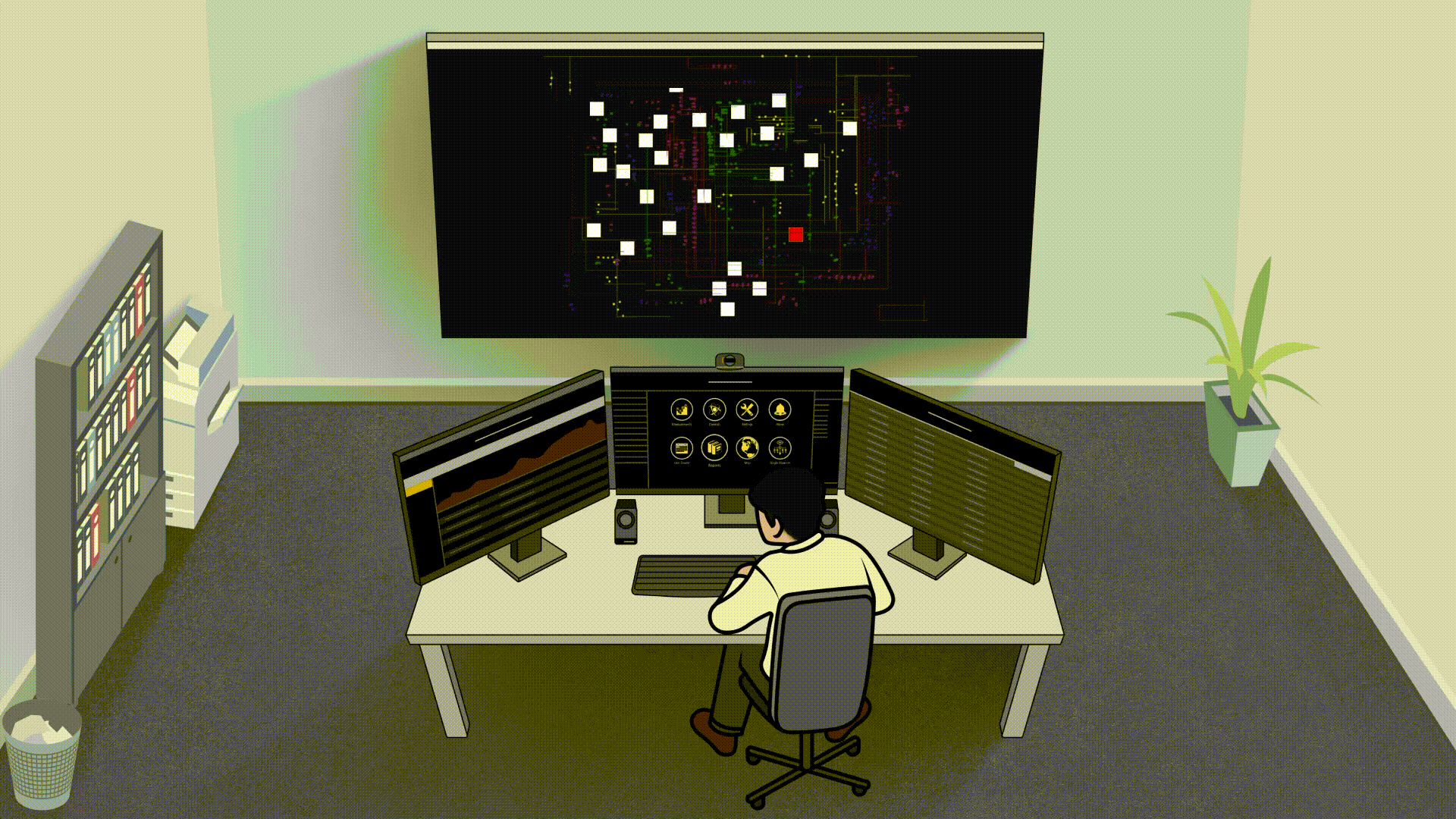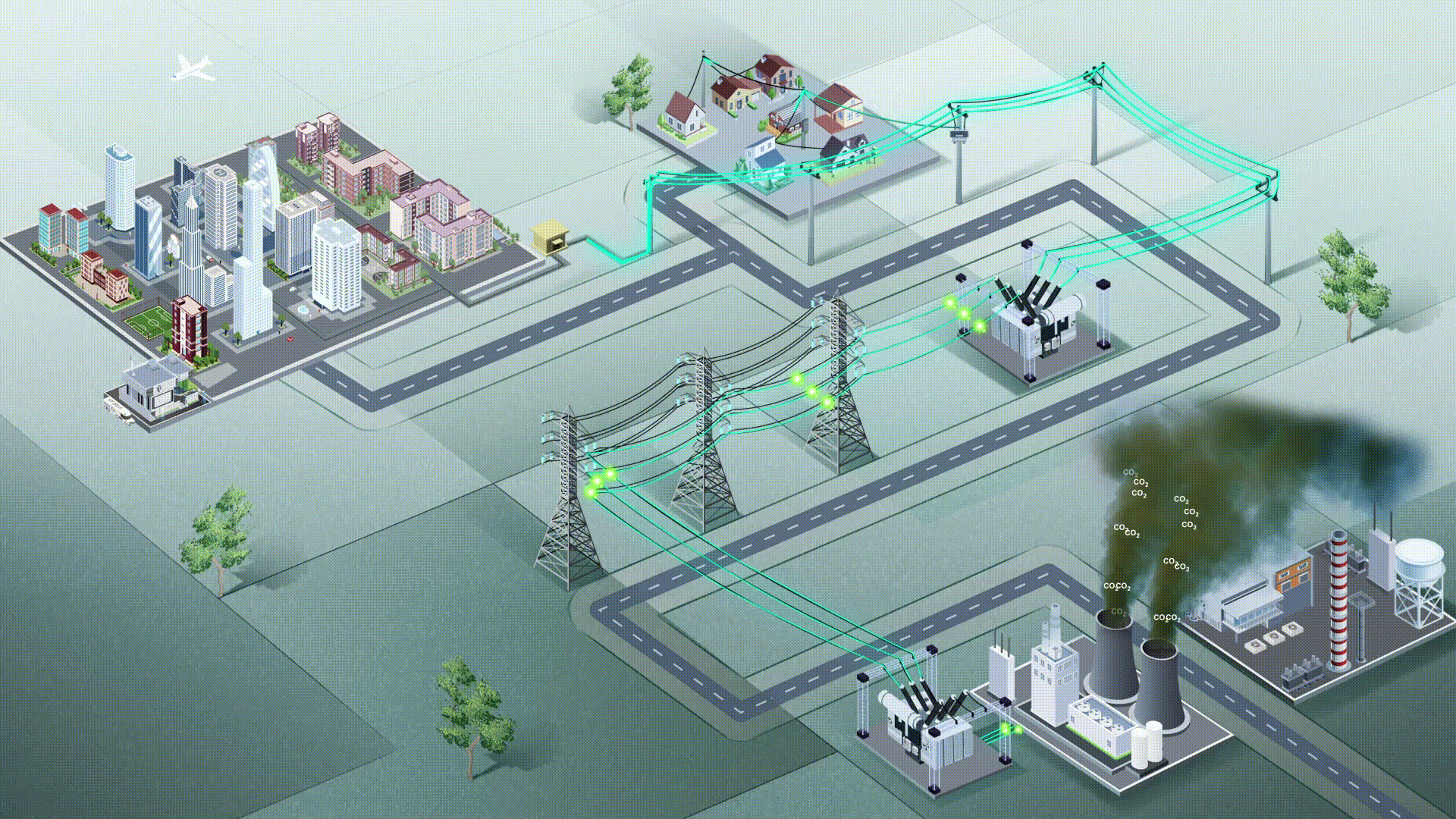14-Aug-2023 |
The key Benefits of Smart Grid Technology for Energy Providers
What is smart grid technology?
A smart grid is an electrical grid that utilizes a digital communication network and modern technology, such as sensors and automatic control systems, to manage, monitor real-time power flow and enhance its efficiency, reliability, and sustainability.
Smart grid is used to upgrade the conventional electrical networks that previously operated on-site, such as when the power cut off and electrical providers had to manually discover the fault location and trip/close switchgear with no information on the currents or voltage, etc. Smart grid technology provides long-term power dependability, increases efficiency by eliminating energy loss, boosts customer confidence, and attracts foreign investors when the electricity is reliable. In addition, smart grid technology aids in the reduction of greenhouse gas emissions, hence reducing global warming.

What are the key benefits of smart grid technology for energy providers?
Smart Grid is crucial for power supply institutions since it is a technology that improves the efficiency of power delivery to customers while ensuring energy stability, i.e. no frequent power outages, hence greatly boosting the institution's revenue.
Here are the benefits for power supply companies when their distribution network is equipped with Smart Grid technology.
1. Technical benefits
Monitoring and Control – The technical team can monitor the load, such as current, voltage, and bias of each phase, monitor data from the energy metering, and remotely trip or close switchgear.
Real-time Alarm Notification – When there is an electrical trip or a power outage due to power sources being cut off, broken branches fall on the distribution line, resulting in a power interruption.
Report and Analysis – It is the most important point for the electricity supplier because it is where the system gather information about its network and where problems need to be addressed.
Safe Operation – Direct operations often faces with numerous threats due to working with medium voltage currents. Therefore, direct and frequent operations are no longer required when the network is equipped with Smart Grid technology. Simply being in the control room enables you to manage and solve problems.
Preventive Maintenance – Smart Grid can extend the lifespan of electrical equipment by detecting and identifying overloads and issues on all equipment, making it easier to plan preventive maintenance in advance.
Upskill of Technical Engineers – In order to manage the distribution line more efficiently, each technician must study more in order to take full advantage of this smart grid technology.
2. Business Benefit
Reduce OPEX/CAPEX – Such as traveling to find the fault and needing a few teams that must pay for fuel, labor, and so on. In terms of OPEX (operating expenses), a power outage, for example, costs $500 per operation. How much does a monthly power outage cost? Plus, reduce CAPEX (capital expenditure) costs such as equipment or electrical equipment purchases to prepare for the acquisition of many vehicles for operation to detect the problem. All of this Smart Gird Technology no longer requires such a high cost.
Reduce Power Loss – Unknowingly, current leakage and long-term power outages due to fault location are far away. As a result of the late restoration, business owners lost revenue from selling electrical power to customers. Smart Grid technology helps transmit information about current leakage to the control room on time without allowing the current to be lost. In addition, when there’s a power outage, Smart Grid technology immediately sends fault information to the control room (fault detector), minimizes the size of the impacted area (fault isolation), and solves the problem only in the fault area (fault restoration). As a result, the power outage is not as severe and does not last as long.
Independent on Business – When he has complete control of the power distribution network, he may plan the business independently. The business owner will understand exactly how his network is performing, what is lacking, and what has to be addressed.
Business Expansion Plan – Once the power supply institution has control of his distribution network, he can plan to further expand his business investment.

3. Benefit to the society
Increase More Investors – Investors will be interested in establishing manufacturers or factories that consume a lot of electricity, mostly because it is seen that the country's electrical supply is stable with few power outages.
Customer Satisfaction – Consumers in this context refer to electrical users in households, small and large businesses, factories, and industries that require energy to operate. They will be overjoyed and may have to increase production due to the consistent power supply.
Mitigate Climate Change – Most of the electricity we use today is generated by coal or black oil, which emits harmful gases into the environment and contributes to global warming. As a result, the implementation of smart grid technology enhances supply efficiency by minimizing power waste and reducing leakage current during distribution to consumers. As a result, the use of coal or black oil is decreasing.

Overall, we can see that smart grid technology gives numerous benefits to power supply institutions, such as increasing supply efficiency, instantly evaluating and monitoring the power distribution network, and increasing power stability by preventing power loss due to power outages or leakages. On top of that, smart grid technology increases consumer confidence by lowering unnecessary operating costs and prices, as well as contributing to lower emissions.
OTHER News
-
Happy New Year 2026! 31-Dec-2025 |
-
DRCs: Cambodia’s Innovation for the Future of Smart Grid 02-Dec-2025 |
-
VP.Start Completes RPM Grid Upgrade in Four Provinces 27-Nov-2025 |
-
Sharing the SIMA Journey in Berlin 24-Nov-2025 |
-
VP.Start: Bringing Global Connectivity to the Future 24-Nov-2025 |
-
The Power of Connectivity: VP.Start’s Global Mission 22-Nov-2025 |
-
Cambodian Innovation for Global Sustainability 19-Nov-2025 |
-
What can school give you? 19-Nov-2025 |
-
What can't school give you? 19-Nov-2025 |
-
VP.Start is a company of Cambodian Innovation 19-Nov-2025 |
-
Strengthening Collaboration Through Communication 18-Nov-2025 |
-
Transforming the Future Through Collaboration 18-Nov-2025 |
-
Cambodian Innovation for Global Sustainability 15-Nov-2025 |
-
Building Trust Through Every Connection 15-Nov-2025 |
-
DRC-001: Empowering the Future of Grid Modernization 15-Nov-2025 |
-
VP.Start: Where Technology Never Stops Evolving 08-Nov-2025 |
-
What is your SIMA Journey? 08-Nov-2025 |
-
What will VP. Start's BOX become in the near future? 08-Nov-2025 |
-
What Future do you want to create? Why? 08-Nov-2025 |
-
What is the Power of Innovation? 08-Nov-2025 |
-
Stay Curious. Stay Playful. Stay Innovative 05-Nov-2025 |
-
Empowering Growth Through Innovation 30-Oct-2025 |
-
We Speak Innovation to Inspire Change 22-Oct-2025 |
-
Enhancing Current Balancing Efficiency with the LMS 22-Oct-2025 |
-
Stop Selling. Start Listening 11-Oct-2025 |
-
Which do you want to become? 10-Oct-2025 |
-
I Saw the Future, and I Have Hope 10-Oct-2025 |
-
How to Become an Innovator 10-Oct-2025 |
-
The Power of Innovation Through Technology 10-Oct-2025 |
-
Why do we need the DRC? 09-Oct-2025 |
-
Data Beyond Technology: The Evolution of Intelligence 09-Oct-2025 |
-
Together Toward an Intelligent and Sustainable Future 04-Oct-2025 |
-
Small Country, Big Innovations 01-Oct-2025 |
-
Revolutionizing Energy Distribution with RPM Grid-AP 20-Sep-2025 |
-
Innovation Belongs to Everyone 17-Sep-2025 |
-
RPM Grid-AP Training for VP.Start Staff 13-Sep-2025 |
-
VP.Start: Driving Innovation for a Sustainable Future 10-Sep-2025 |
-
VP.Start: Innovation That Drives Global Impact 10-Sep-2025 |
-
What Makes the RPM Grid-AP Stand Out? 08-Sep-2025 |
-
What Is the Role of the RPM Grid-AP? 08-Sep-2025 |
-
RPM Grid-AP A Revolutionary Smart Grid Management System 06-Sep-2025 |
-
The Evolution of DRC: From Birth to Breakthrough 03-Sep-2025 |
-
RPM Grid-AP 29-Aug-2025 |
-
DRC-003: A Missing Link for the Smarter Grid 29-Aug-2025 |
-
A Revolutionary Solution for the Grid Transformation 27-Aug-2025 |
-
A Consumer-First Philosophy at VP.Start 27-Aug-2025 |
-
Issues, Solutions, Impacts: The Power of EcoGrid 27-Aug-2025 |
-
Commissioning RPM Grid-AP for EDC 27-Aug-2025 |
-
Innovation! 21-Aug-2025 |
-
What Makes DRC-003 a Powerful Tool in Energy Management? 21-Aug-2025 |
-
How Does DRC 003 Respond to Powerline Faults? 21-Aug-2025 |
-
DRC-003 A Watchful Guardian for Auto Recloser 21-Aug-2025 |
-
How Does DRC-003 Reduce Operational Costs? 19-Aug-2025 |
-
The Uniqueness of DRS 14-Aug-2025 |
-
Why Do Utilities Need to Use DRS? 14-Aug-2025 |
-
What Will the DRC- 012G Become in the Future? 12-Aug-2025 |
-
DRC-012G A Game-Changer for Energy Meter Management 10-Aug-2025 |
-
Why Did VP.Start Develop the DRC-012G? 06-Aug-2025 |
-
What Makes the DRC-012G Outstanding? 06-Aug-2025 |
-
What Challenges Can the DRC-012G Tackle? 06-Aug-2025 |
-
The Roles of the DRC-012G in Energy Meter Management 06-Aug-2025 |
-
How Can the DRC-012G Enhance Energy Efficiency? 06-Aug-2025 |
-
DRS Reduces Energy Losses 03-Aug-2025 |
-
How Does DRS Revolutionize Meter Management? 03-Aug-2025 |
-
Why Did VP.Start Create DRS? 03-Aug-2025 |
-
Why does VP.Start need to go international? 31-Jul-2025 |
-
What Is the Green Innovation of VP.Start? 30-Jul-2025 |
-
How Does DRC-004G Contribute to Combating Climate Change 30-Jul-2025 |
-
Key Roles of the DRC-004G in Metering Management 26-Jul-2025 |
-
How Does DRC-004G Optimize Energy Efficiency? 23-Jul-2025 |
-
What Challenges Can the DRC-004G Address? 23-Jul-2025 |
-
How do we create a high-quality solution at VP.Start? 20-Jul-2025 |
-
What Are The Key Features Of The DRC-018? 20-Jul-2025 |
-
What Is DRC-018? 18-Jul-2025 |
-
How Can DRC-018 Streamline Operations? 18-Jul-2025 |
-
DRC (Distribution Remote Control) 14-Jul-2025 |
-
What builds our momentum and moves us forward? 14-Jul-2025 |
-
What makes our journey work? 14-Jul-2025 |
-
How Can We Reach Our Goal If We DON'T START NOW? 14-Jul-2025 |
-
VP.Start Expert Engineer Presents LMS at EDC Takeo 10-Jul-2025 |
-
VP.Start Expert Engineer Presents LMS to EDC Kampot 10-Jul-2025 |
-
VP.Start’s Eco-sustainable System for the Future 08-Jul-2025 |
-
DRC-006 Is an Eco-solution for Grid Modernization 08-Jul-2025 |
-
DRC-006 Optimizes Efficiency and Reduces Losses 08-Jul-2025 |
-
How Does the DRC-006 Make Benefits for Utilities 08-Jul-2025 |
-
What Can Utilities Do with DRC-006? 05-Jul-2025 |
-
DRC-006 ls Designed to Streamline RTUs Operations 05-Jul-2025 |
-
DRC-009 An Eco-Solution Designed for Ring Main Units 03-Jul-2025 |
-
DRC-009 Streamlining Operations 03-Jul-2025 |
-
How is DRC-009 Operated? 03-Jul-2025 |
-
RPM Grid-AP One Platform to a Nationwide Control System 03-Jul-2025 |
-
How Does DRC-009 Make Benefits for Utilities? 29-Jun-2025 |
-
The Power of the Circle 28-Jun-2025 |
-
What Challenges Can DRC-015 Address? 19-Jun-2025 |
-
How Can the DRC-015 Make Benefits for Utilities? 19-Jun-2025 |
-
How Can the DRC-002 Streamline Grid Operations? 14-Jun-2025 |
-
What Are the Powerful Features of DRC-002? 14-Jun-2025 |
-
What Is the Next Version of the DRC-002? 14-Jun-2025 |
-
A Vigilant Reporter Transmitting Data to LMS 14-Jun-2025 |
-
What Dose It Really Mean to be Data-diven? 12-Jun-2025 |
-
What Are the Roles of DRC-002 in Modern Grid Management? 12-Jun-2025 |
-
What is your Endless Journey? 09-Jun-2025 |
-
What Makes You Different? 09-Jun-2025 |
-
What Moves You Forward? 06-Jun-2025 |
-
What Drives You a Story? 05-Jun-2025 |
-
VP.Start in the Sustainable Smart City Workshop 04-Jun-2025 |
-
What Makes NiteLite System Standout? 01-Jun-2025 |
-
NiteLite Enhances EnergyEfficiency 01-Jun-2025 |
-
NiteLite Increases Cost Efficiency 01-Jun-2025 |
-
What Will DRC-001 Look Like in the Future? 31-May-2025 |
-
How Can the DRC-001 Make Return on Investment? 29-May-2025 |
-
The Spirit of Relentless Growth 29-May-2025 |
-
The 3 Outstanding Features Of AlienCheck 28-May-2025 |
-
DRS Enhances Power Quality 28-May-2025 |
-
What Is the Next Version of LMS? 28-May-2025 |
-
The Innovation Behind the DRC-015 in Modern Grid Systems 28-May-2025 |
-
AlienCheck: Universal Connectivity Network (UCN) 28-May-2025 |
-
Instant Alarm for Anomalies on the Powerlines 22-May-2025 |
-
Seamless Remote Control Capability 17-May-2025 |
-
Streamline Electrical Grid Management 17-May-2025 |
-
Reduce Operational Costs and Improve Energy Efficiency 16-May-2025 |
-
RPM Grid-AP 10-May-2025 |
-
PLUM App (Power Line Utility Management) 10-May-2025 |
-
VP.Start Presentation on DRS for EDC Mondulkiri 08-May-2025 |
-
VP.Start Presentation on DRS for EDC Ratanakiri 07-May-2025 |
-
VP.Start Presentation On DRS to EDC Kratie 06-May-2025 |
-
The SIMA Journey – our ideology 02-May-2025 |
-
What does VP.Start believe? 02-May-2025 |
-
DRS (Advanced Metering management System) 02-May-2025 |
-
RPM Grid System (Remote Power Medium Voltage Grid) 02-May-2025 |
-
How Can We Harness Data for a Sustainable Future? 23-Apr-2025 |
-
The Smart City Presentation to Takeo Provincial Governor 08-Apr-2025 |
-
VP.Start’s CEO Visited EDC Kampong Cham 12-Mar-2025 |
-
VP.Start’s CEO Visited EDC Tboung Khmum 12-Mar-2025 |
-
VP.Start’s CEO Visited Electric Licensees 20-Feb-2025 |
-
VP.Start’s CEO Visited EDC Siem Reap 19-Feb-2025 |
-
VP.Start’s CEO Visited EDC Sihanoukville 18-Feb-2025 |
-
VP.Start’s CEO visited ELECTRICITE DE BATTAMBANG 12-Feb-2025 |
-
VP.Start Visited Electricity of Bateay Meanchey 12-Feb-2025 |
-
DRS Presentation for EDC Takeo 07-Feb-2025 |
-
VP.Start's BOX Engineering Day 2024 at RUPP 26-Oct-2024 |
-
MISTI Visits VP.Start Campus to Explore New Technologies 10-Sep-2024 |
-
VP.Start Visits North Star Group in Hanoi, Vietnam 06-Sep-2024 |
-
Sustainability Recognition Award 31-Aug-2024 |
-
Proudly Cambodia, Boldly International 06-Aug-2024 |
-
Why VH-012-1C is the Best Choice for a Smart Home? 22-Jul-2024 |
-
The Presentation of DRC Solutions to EDC Takeo 26-Jun-2024 |
-
Presentation at Borey Peng Huoth Boeung Snor Community 11-Jun-2024 |
-
GRID CALCULATION, License Men Khunthea 11-Jun-2024 |
-
The 9th GEE Family Reunion at ITC 08-Jun-2024 |
-
Presentation at CHIP MONG 271 04-Jun-2024 |
-
The Objective for Enhancing Pedagogy (OEP) 30-May-2024 |
-
The Visit and Presentation to EDC Takeo 28-May-2024 |
-
The Visit to the Huawei Technology (Cambodia) office 21-May-2024 |
-
Baksey Media (Technology Cambodia) 26-Apr-2024 |
-
Visit by the World Bank Group 03-Apr-2024 |
-
Visited to ENTEC foreclosure 16-Mar-2024 |
-
Visited LS Electric and PECC2 14-Mar-2024 |
-
Why Needs to Update the Conventional Grid to Smart Grid? 09-Jan-2024 |
-
GRID CALCULATION, License Vorn Virak Services 21-Dec-2023 |
-
Bro Tip Project for "Ministry of Mines and Energy" 25-Nov-2023 |
-
Balancing the Grid 22-Nov-2023 |
-
What Is RPM Grid? 24-Oct-2023 |
-
Getting to Know the Electrical Grid 07-Sep-2023 |
-
Industry 4.0 in Cambodia at the ASEAN Factori 4.0 25-Aug-2023 |
-
Presentation to EDC Banteay Meanchey 15-Mar-2023 |
-
Presentation to EDC Siem Reap 14-Mar-2023 |
-
Presentation to EDC Stung Treng 28-Feb-2023 |
-
Presentation to EDC Kampong Cham 23-Feb-2023 |
-
Presentation to EDC Svay Rieng 21-Feb-2023 |
-
Business Presentation to EDC Kampot 07-Feb-2023 |
-
Business Presentation to EDC Mondul Kiri 25-Jan-2023 |
-
Business Presentation to EDC Kratie 24-Jan-2023 |
-
Presentation EDC Tboung Khmum 23-Jan-2023 |
-
Presentation DRC-006 to DCC of EDC Phnom Penh 01-Nov-2022 |
-
Basics of Distribution Grids & Managing Grid Stability 12-Oct-2022 |
-
Street Light Presentation at Kandal Province Hall 26-Aug-2022 |
-
Business Presentation and Visit in Malaysia 13-Aug-2022 |
-
Presentation Street Light at Kandal Province 28-Jun-2022 |
-
Business Presentation to EDC Phnom Penh, DCC 30-Mar-2022 |
-
5 Ways To Reduce Your Electricity Bill 23-Sep-2021 |
-
Presentation DRC-009 to DCC of EDC Phnom Penh 05-Jan-2021 |
-
Celebrating 6 Years of Achievements & The New Year 2021 30-Dec-2020 |
-
Presentation to Rural Electrification Fund 09-Dec-2020 |
-
Presentation to EDC Bunteay Mean Chey 03-Dec-2020 |
-
Presentation to Business and Distribution Department 29-Sep-2020 |
-
Department of Rural Electrification Fund 09-Sep-2020 |
-
Presentation to EDC Ratanakiri 21-Jun-2020 |
-
Presentation to EDC Tbong Khmom 04-Jun-2020 |
-
Presentation to EDC Kampot 07-May-2020 |
-
Presentation to EDC in Phnom Penh City 23-Jul-2019 |
-
Sales Team Presents To The EDC at Svay Rieng 20-Dec-2018 |
-
Presentation to EDC Kratie 20-Jun-2018 |
-
EDC Tbong Khmum Presentation 03-May-2018 |
-
Siemens Team Visit at VP.Start 02-Feb-2018 |
-
Presentation to BVC Power 01-Jan-2018 |
-
EDC Kampot Presentation 19-Jul-2017 |
-
Business Presentation to EDC Kampong Speu 17-Jul-2017 |
-
Presentation to EDC Battambang 23-Nov-2016 |
-
Presentation to EDC Kampong Cham 04-Nov-2016 |
-
Presentation to Electricity of Sihanouk Province 26-Oct-2016 |
-
Business Presentation to EDC Siem Reap 18-Oct-2016 |